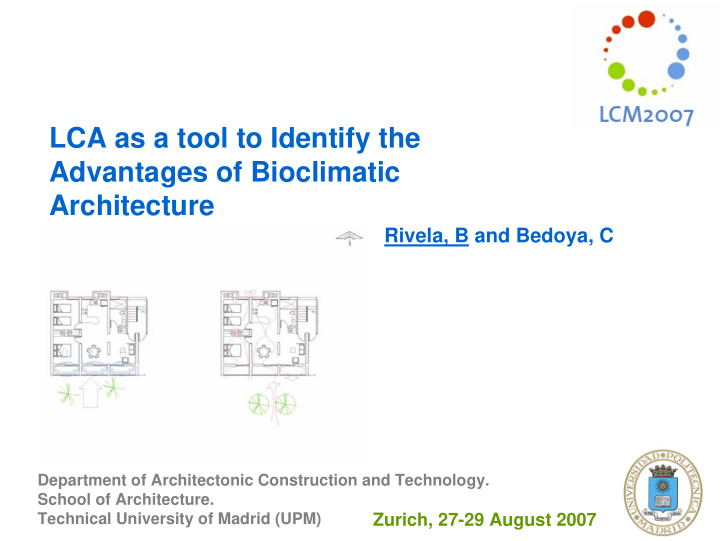



LCA as a tool to Identify the Advantages of Bioclimatic Architecture Rivela, B and Bedoya, C Department of Architectonic Construction and Technology. School of Architecture. Technical University of Madrid (UPM) Zurich, 27-29 August 2007
Structure 01 Short Introduction 02 Goal and scope 03 Life Cycle Inventory 04 Impact Assessment 05 Conclusions Zurich, 27-29 August 2007
oduc tion t Intr 01. Shor
Introduction (I) Why Construction? 50% of all materials extracted from the earth’s crust 40% of all energy end use (similar percentage of greenhouse gas emissions) 40-50% of waste 28.1% of industrial employment (7.5% of total employment) Zurich, 27-29 August 2007
Introduction (II) Sustainable Construction? Sustainable Ecological Organic Green Tradition vs. Technology Technological imperative Vernacular architecture Zurich, 27-29 August 2007
Introduction (III) 01 Bioclimatic architecture …working with natural forces around the building rather than against them. climate energy Zurich, 27-29 August 2007
02. Goal and Sc ope
Goal & Scope (I) 01 Objective Assess the importance of bioclimatic design related to the environmental impact of the entire life cycle of building 01.1 Relative contribution of different materials including the production and manufacturing of construction materials involved as well as the process of the envelope construction 01.2 Comparative analysis of construction vs. use phase 02 Functional unit Environmental Impact E nve lope A E nve lope B Ma te ria ls (A) + x kWh Ma te ria ls (B) + y kWh 150 m 2 Zurich, 27-29 august
Goal & Scope (II) 03 Scenarios under study 3.1 Envelope A Outdoor Exterior rendering (2 cm) Wood-fibre insulation (6 cm) Brick (24 cm) Plastering (1.5 cm) Indoor 3.2 Envelope B Outdoor Exterior rendering (2 cm) Brick (12 cm) Rendering (1 cm) Polyurethane Insulation (4 cm) Brick (5 cm) Plastering (1.5 cm) Indoor Zurich, 27-29 august
y ife Cyc le Inve ntor 03. L
Inventory 01 Construction materials 6 m 02 Energy use 6 m 12 m Winter (kWh) Summer (kWh) San San Envelope Sebastian Madrid Seville Sebastian Madrid Seville A 239,805 226,665 200,385 42,705 45,990 49,275 B 640,575 558,450 440,190 279,225 374,490 436,905 � Operations phase activities considered include heating, cooling and ventilating the building. � Lighting, water supply and water heating were leaved out Zurich, 27-29 august
04. Impac t Asse ssme nt
Impact Assessment (I) 01 Relative importance of materials 02 Relative importance of construction vs. use phase 03 Comparative assessment of envelopes Zurich, 27-29 august
Impact Assessment (II) 01 Relative importance of materials: envelope A 100% Exterior rendering Wood-fibre insulation Brick Plastering C RO RI CC R OL E A/E LU M FF Zurich, 27-29 august
Impact Assessment (III) 01 Relative importance of materials: envelope B Exterior redering Brick (12 cm) Polyurethane Rendering Brick (5 cm) C RO RI CC R OL E A/E LU M FF Plastering Zurich, 27-29 august
Impact Assessment (IV) 02 Relative importance of construction vs. use phase C RO RI CC R OL E A/E LU M FF Construction Use phase Zurich, 27-29 August 2007
Impact Assessment (V) 03 Comparative assessment of envelopes 50 40 30 20 10 0 C RI CC E A/E FF Envelope A 50 40 Envelope B 30 20 10 0 HH EQ R Zurich, 27-29 August 2007
05. Conc lusions
Conclusions 01 Bioclimatic strategies are ease of application with minimum additional investments, and provide a large reduction of the environmental impacts 02 The use phase is of major importance in the scenarios analysed 03 Further research must be done… Zurich, 27-29 August 2007
www.larevolucioninvisible.com
Recommend
More recommend